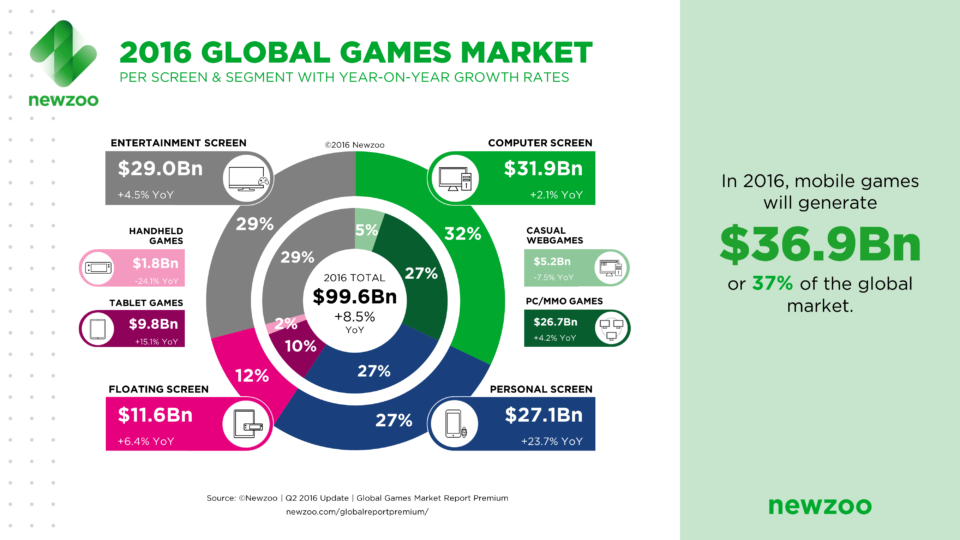Newzoo predicted that in 2016, revenue from tablets and smartphones will generate $36.9 billion U.S. dollars in revenue. This will comprise 37 percent of the total market, making it the first year that mobile game revenue is expected to be greater than either console gaming or PC gaming, which are pegged at $31.9 billion U.S. dollars and $29 billion U.S. dollars respectively.
While this is a clear demonstration of the growth of the mobile market, which is expected to increase its share as the total revenue of the gaming industry is expected to be $118.6 billion in 2019, it does not mean the end for either gaming on PC or consoles. In fact, PC gaming is expected to see a 2.1 percent increase in revenue this year while console gaming revenue will rise 4.5 percent.

It seemed like the continued rise of mobile gaming might displace console gaming and many predicted just that a few years ago. That doesn’t seem to be the case, however, and we’re going to name the various ways that neither mobile nor console games will replace the other.

Mobile Definitely isn’t Going Away…
Mobile is clearly going to be the thing that will make huge bank consistently, at least for the biggest publishers. It reaches a potentially much wider worldwide audience since a huge percentage of the world’s population owns a smartphone. Those that get hits are hit big, generating millions of dollars every day. We are fast approaching the day when nearly every adult person in an industrialized country owns a smartphone.

The utility of a smartphone and tablet also can’t be understated. Having the functionality of a calculator, flashlight, phone, video streamer, game player and a PDA built into one device makes them one of the largest conveniences to everyday life that’s come around in a long time. Smartphones have changed the way we organize our lives and how we communicate and find out information.
Publishers of smartphone games have also mastered the art of appealing to mass audiences. Part of that is releasing games that are free that still incentivize people to put money in them. Developers like MachineZone, Supercell and King have perfected this with various titles, which appeal to a wide variety of age groups and people of different socioeconomic statuses. Whether you just want to get in and play a little during your lunch break or are a hardcore player for a few hours every night, dropping hundreds of dollars monthly, these games cater to a wide variety of tastes.
…But Neither are Consoles
While smartphones are by design convenient and streamlined, that means the control methods of mobile are, for the most part, limited. A touchscreen and some gyroscopic capabilities are what’s built into a phone and that’s generally all developers can count on mobile developers to have. By contrast, with the console experience all users have a controller that at minimum has 10+ buttons and triggers, two analog sticks and a D-pad. One can simply do more with those sorts of controls, and they’re much better suited to the games hardcore players want to play.
There are also different sets of established expectations for both mobile and console games, regardless of control methods. Console experiences trace their roots back to the origins of gaming at home, where users would spend a certain amount on a game and the goal is to finish the games objective using skill. That’s a simplification, but it’s been basically true for over three decades. For mobile gaming, generally the games themselves are free (at least the most popular ones) with microtransactions built into the experience, with the origins in the rise of social gaming on Facebook. These transactions are an important part of the experience, particularly in competitive games, and while the user that spends more is not guaranteed to win, they most certainly have an advantage. These two perspectives on gaming are at odds with each other, and the sorts of people that would play and enjoy one wouldn’t necessarily enjoy the other.
There’s also the difference in scope between smartphone and console experiences. Someone looking to play a game experience like Batman: Arkham Knight, The Witcher III: Wild Hunt or Uncharted 4: A Thief’s End aren’t going to be sated by the likes of Clash Royale, Candy Crush or Game of War: Fire Age. The capacity and production values of those console experiences, played on a a large HD television, is much more expansive than the mobile experience.

What mobile has done is take a chunk out of the portable console market. As we’ve previously written about, the market for portable console games has demonstrably shrunk while the mobile/tablet market has flourished. This is in part due to the increasing penetration of smartphones/tablets into homes, their greater utility than portable consoles, and the fact that consumers tend to always have a smartphone/tablet with them, regardless of their location. Still, the home console market has not appeared as adversely affected by the rise of smartphones.
On the business side, console gamers have continued to show a willingness to purchase games at launch for +$60, and that’s going to generate a lot of money for hit games. Plus, digital sales are fully a thing now; there are plenty of monetized skins and other cosmetic items to purchase, DLC content updates in addition to the games themselves, most of which are available on day-one. It makes the biggest hit games for consoles huge generators of money from their insatiable fanbases.
Our Future in the Clouds
Instead of one type of gaming consuming each other, gaming on televisions and mobile devices seems to be coexisting with each other. What we’re seeing is a re-positioning of the way people spend their time. While some people will spend time with certain devices over another, most people will probably be splitting their time playing games across multiple devices.
“Playing games on the TV or PC will not disappear,” says Vincent van Deelen, market analyst at Newzoo. “They are different screens, each with their own right of existence. What we see happening now is that money spent on games is gradually being spent more equally across all four screens. Ultimately this could be 25 percent for TV, 25 percent for PC, 25 percent for tablets and handhelds, and 25 percent for phones. In the U.S., the percentages are 44 percent, 26 percent , 15 percent, and 15 percent respectively. On a global scale, the split is closer to the theoretical situation: 28 percent, 39 percent, 13 percent, and 20 percent. Time spent on games has already shown a close-to-equal split across screens for years.”
Looking into the future, there’s a decent chance that all games will be streamed to devices rather than downloaded or on a physical disc. Sony’s already offering a streaming service with PlayStation Now, which is primarily designed for various PlayStation devices but does have some functionality with Windows PCs and some smart TVs. It’s not too hard to imagine a future where games are streamed to every device and that will be the primary way to play games - maybe set-top boxes will become an important part of the gaming landscape. Until the cloud makes that possible, consoles and smartphones will likely continue their own success along parallel paths.

Comments










